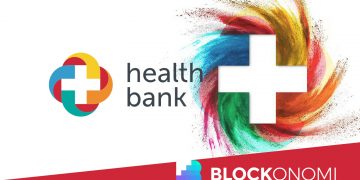Healthbank aims to revolutionize the way that we exchange, monetize, and store personal healthcare data. This health data exchange platform connects stakeholders within the health ecosystem upon the request of the user, or patient. When the user chooses to, healthbank additionally processes and exchanges data.
The team behind healthbank recognizes that in today’s world, healthcare data are incredibly complex without the patient (the end user) usually seeing it. Data are currently stored in various closed ecosystems and tend to sit dormant. It is also incredibly challenging at the moment to exchange personal healthcare data, meaning it is rare for patients or their care providers to have a full record.
Healthbank will overcome these issues by taking advantage of the shift to health consumerism and how this change drives the way care is accessed and delivered. Patients have more choices and data available to them than before. With the healthbank ecosystem, users can securely store and exchange data with wellness, lifestyle, healthcare, and pharmaceutical service providers.
What Are the Key Parts of Healthbank?
There are two organizations within healthbank, and they have a symbiotic relationship. The core solution is healthbank cooperative, where patient data are stored on a fully secure digital platform that patients (members) govern. Healthbank innovation AG is the platform manager that is responsible for developing services, integration of partners, applications, and data processing, all on behalf of users. Healthbank cooperative is people-owned, while healthbank innovation AG is compliant. Neutral user consent connects these organizations.

Advantages of Healthbank
Healthbank offers users a list of advantages, including the fact that its coin is not simple. Instead, the coin is a healthbank cooperative equity that works as a security token and asset. The funding goes toward a proven business model.
Healthbank already created a market-proven and operational healthcare ecosystem that is live and tokenized. In fact, there are already more than 200,000 live users. The fact that the healthbank funding is for a proven model gives it a strong advantage over other similar projects, which still require further development.
Additionally, users and investors should appreciate the fact that the team behind healthbank is made up of experienced healthcare practitioners, as well as regulatory experts and technologists. This team already has a track record of successfully scaling digital health solutions.
HBE Healthbank Tokens
HBE, the token behind healthbank, is an ERC-20 token. The equity token represents a share of the healthbank cooperative. There is a maximum supply of 4 billion HBE, with 2.2 billion for sale. This includes 5 percent of the total tokens for the private sale, 3 percent for the member sale, 17 percent for the pre-ICO, and 30 percent for the ICO. Fifteen percent is reserved as an early user onboarding incentive, 5 percent for the ICO fees, 5 percent for the team, and 20 percent for the market cap. Those who hold the HBE token will receive dividend rights and a long-term increase in the value of the token.

The HBC token is internal, meaning that it is only used within the healthbank platform. Within the platform, the token serves several functions. It can be redeemed for health services. Users can receive the token for health data or services exchanged by the individual users. It is also possible to exchange the HBC tokens for HBE tokens at a 1:1 ratio. The HBC token is designed to provide an incentive for stakeholders in the ecosystem to develop services and exchange healthcare data on the platform.
Token Sale Details
During the token sale, contributions can be made in ETH, CHF, and EUR. There is no soft cap, and the hard cap is set to CHF 27.6 million. If any of the allocated 2.2 billion tokens are unsold, they will be held for future membership. The token sale is already in the ICO stage, having completed the private sale and FINMA approval in Q2 2018 and the pre-ICO in Q3.
Prior to the member sale, existing members were able to purchase HBE with a discount of 30 percent. Advisors and team members of healthbank will receive 5 percent of total HBE tokens if the ICO is successful. During the public pre-ICO, investors received a 25 percent discount on HBE tokens. The public sale will be open for 12 weeks.
The token proceeds will be divided amount three main tasks. Onboarding clients to the existing platform accounts for 37 percent of proceeds, with healthbank 2.0 accounting for 45 percent and supporting operations for 18 percent. Of those supporting operations, 7 percent is for loan repayment and contingent liabilities, 9 percent for the back office, and 2 percent for customer service. Of the proceeds going toward healthcare 2.0, 21 percent is for development; 9 percent for blockchain and distributed ledger technology; and 15 percent for data analytics, AI, and deep learning. Of the onboarding allocation, 12 percent is for production of healthbank 1.0, 23 percent for BD and marketing, and 2 percent for ops excellence.
Healthbank Roadmap
The healthbank roadmap began all the way back in May 2013, when healthbank cooperative was founded with 35 members. In June 2015, the team founded healthbank innovation AG, with the go-live of the first platform release in July 2016. That month also saw the alpha release and the first B2B customer, the rollout of the first mobile applications, and the second release of the platform.

September 2016 included the beta release and the first B2B customer. By May 2017, healthbank made the architecture decision. By March 2018, there were 200,000 users.
In June 2018, healthbank had platform 2.0 on PaaS as well as end-to-end encryption. The following month, there were three B2B customers live. The pre-ICO took place in September, with the health data marketplace getting ready by October.
February 2019 will feature the public ICO. By March, the emerging market application will be ready. After this, healthbank will work with AI.
Conclusion
Healthbank is a platform designed to serve as a hub for health-related data. The platform will deliver privacy and the ability to store and monetize data, all while complying with regulatory frameworks. The platform already has 200,000 users, indicating a successful product instead of one that still needs full development.
Useful Links
Credit: Source link























